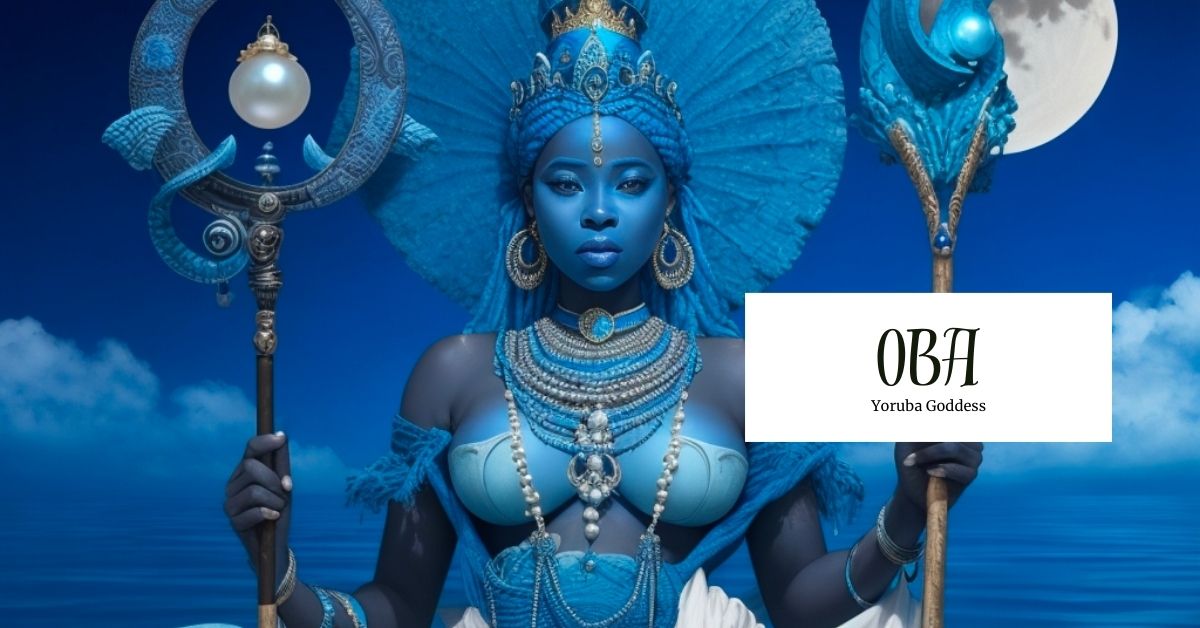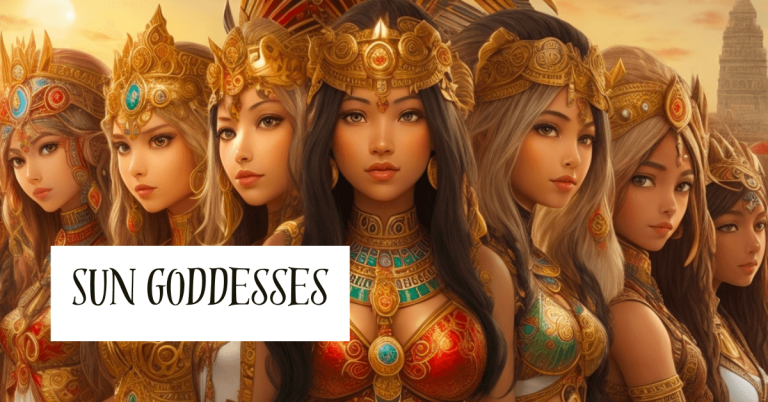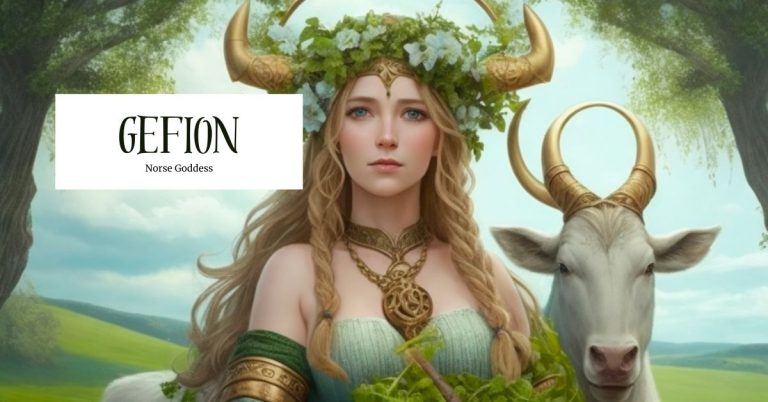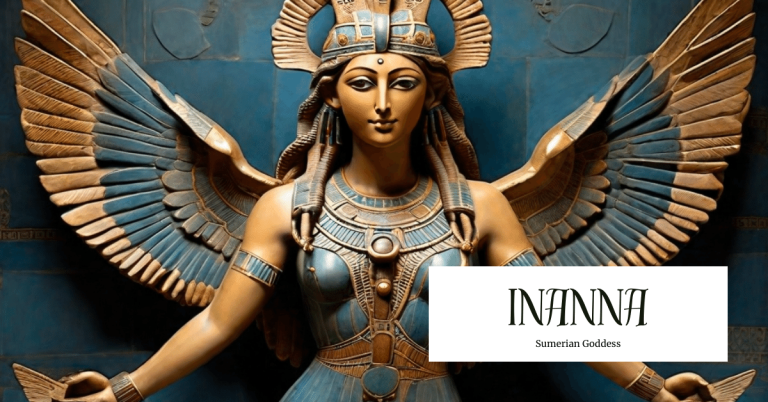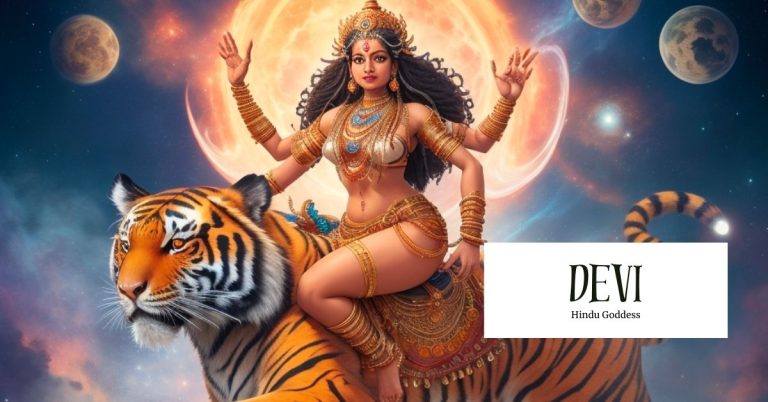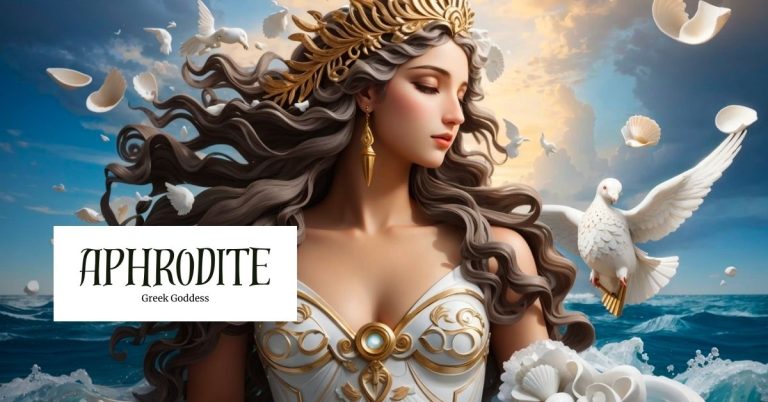Oba: The Goddess of the Rivers
Oba is a revered goddess of rivers and the waters within the Yoruba religion. Her worshippers occupy a place within the cultural and spiritual tapestry of the Yoruba people of West Africa. Her dominion over water and fertility hold deep significance. She is portrayed with elegance, often by flowing water, and commands rivers, streams, and bodies of water. But, her influence extends beyond the physical realm, as she encompasses the role as a guardian of women and an intermediary bridging the mortal and divine realms.
Overview of Oba

Oba is known for her power over water, and is believed to govern its life-giving qualities of fertility and cleansing. Oba is of most assistance to faithful wives and prostitutes, who are often at risk to lose everything that they love. But, she also looks over women who are married to neglectful, cheating, and/or abusive spouses.
She is depicted as a regal and beautiful figure. She is often portrayed around flowing water, which symbolized her power over rivers, streams, and other bodies of water. Her influence goes beyond the physical realm, as she is also considered to be a protector of women. She also plays a role in the spiritual realm, as she acts as an intermediary between the mortal and divine worlds.
There are various rituals and ceremonies that are dedicated to Oba in Yoruba traditions. She is celebrated annually in various festivals such as the “Oba Festival,” where her followers come together to honor and speak about the goddess.
She is still celebrated widely today and has modern practitioners of Yoruba religion and spirituality. Since she has such a profound connection between water, life, and spirituality, she remains a vital symbol of the sacred feminine.
Titles
- Goddess of the River
- Goddess of the Water
- Goddess of Fertility
Abilities
Oba, the goddess of the river, has a wide variety of abilities that reflect her ability to give life. She has the ability to give fertility, and guides women through childbirth and helps the growth of crops through her influence on water sources. Oba has various healing capabilities that extend over emotional well-being, and offer solace and renewal to those in need. She is a guardian of rivers and bodies of water, so she is also able to safeguard her communities from floods and disasters.
In Yoruba spirituality, Oba serves as the goddess between mortals and the divine, as she has rituals and ceremonies facilitated communication and blessings. She has a symbolic presence that transcends time, sustaining her relevance as a protector, nurturer, and the embodiment of the sacred feminine in Yoruba culture.
Characteristics

Source – Journeying to the Goddess
Oba is characterized by an aura of regal magnificence and ethereal beauty. She is often shown with flowing garments that mirror the water that she governs. Her skin is often portrayed in shades of blue or green, which symbolize the connection that she has to water. Her eyes hold a depth that mirrors the vastness of water.
Her hair usually cascades in waves and she is adorned with shells and pearls. She has a crown that graces her head. Oba’s overall presence radiates an aura of serenity and power, which is a harmonious balance between her nurturing nature and her authoritative command over natural forces.
Oba embodies a graceful poise, which is a reminder of the rhythmic flow of rivers. She exudes an air of maternal protection. Her physical appearance and demeanor encapsulate her role as a symbol of both the tranquil waters that sustain life and the forceful currents that shape the world around us.
Traits
Oba has a personality that weaves together strength, compassion, and wisdom. Her character reflects the flowing nature of water and adapts to various situations while being able to maintain a consistent essence. She exudes a maternal warmth and empathy, as she is able to offer solace and guidance to those who are seeking comfort. Oba has a nurturing spirit that is evident as she is a protector of women and children. She is patient and understanding and is able to connect with individuals on a profound emotional level.
But, beneath her gentle exterior is determination and authority. Oba commands the power of rivers and the life that she sustains, which showcases her control over both the delicate and forceful aspects of existence. She has wisdom as deep as the water that she governs.
Oba is both approachable and regal, embodying the balance between approachability and divine majesty. Her character represents the intricate interplay of life’s complexities and the necessity for adaptability in the face of change.
Symbols

Source – Journeying to the Goddess
One of Oba’s most prominent symbols is the flowing water itself, which is often depicted in her attire and her surroundings as a visual reminder of her control over rivers and the life-sustaining flow.
Oba has a regal crown that is adorned with intricate designs that symbolizes her sovereignty over the waters. It represents her authority and divinity echoing the majestic currents she governs. She is also seen with shells, pearls, and aquatic creatures that act as symbols of the ocean’s treasures and inhabitants.
The crescent moon, which symbolizes the cycle of water’s movement is another significant emblem associated with Oba. This ties her to the cyclical nature of life and nature’s rhythms.
She is also often associated with the color blue, which mirrors the hues of water and sky and signifies her connection to the aquatic realm. Also, the staff that she is often seen carrying represents her guiding presence as she leads individuals through the journey of life’s ups and downs.
Festivals and Rituals

Source – Journeying to the Goddess
The festivals that are dedicated to Oba are vibrant and are held in honor of her influence. One of the festivals is the “Oba Festival,” which is an annual event where worshippers gather to pay homage through various rituals, dances, and offerings. There are various processions that highlight Pba’s regal stature. Participants wear blue and green, reflecting the water. There are ceremonies held by riverside and streams to connect to the goddess of the water. With these festivals, communities express their gratitude for her blessings, seek her guidance, and reinforce the cultural ties that bind them to the goddess of the river.
Legends associated with Oba
Since there is the “Oba River,” there are a few legends that tell how that was created.
Origin story

Oba’s origin unfolds within the Yoruba pantheon, where she emerges as a daughter of Yemaja, the revered mother goddess, and takes her place as one of the wives of Sango, the thunder and lightning deity. In this divine lineage, Oba is intricately connected to the forces of nature and their essential roles in the cosmos. Alongside her sisters, Oshun and Oya, she forms a sacred triad, collectively embodying the life-giving waters that sustain the world.
Her lineage and position within this triad shape Oba’s character and influence. As the daughter of Yemaja, her nurturing aspect is enhanced, while her role as Sango’s wife infuses her with strength and authority. The triad’s combined power underscores their vital contributions to existence—Oshun’s charm, Oya’s tempestuousness, and Oba’s regal presence culminate in a balanced interplay that mirrors the intricate dance of life’s elements.
Oba and Oshun Fighting for Shango

As Oba and Oshun were both the lovers of Shango, this story began with them trying to win the love of their common husband. Shango was the lover of Oshun, but the husband of Oba and Oya. Oshun was apparently the best cook, and therefore the favorite. Oba became jealous of Oshun and asked how she was able to keep him so happy.
Oshun was resentful because Oba’s family and children would be the ones to inherit the kingdom. So, Oshun told Oba that many years ago she cut off a piece of her ear, dried it to a powder, and then sprinkled it into his food. And this is what made him desire her over the others. So, Oba followed the instructions.
Later, when Shango was eating his food, he saw a piece of ear floating in his food. He thought that Oba was trying to poison him and banished her from the house. As she was grieving, she fell to earth and became the Oba River, which intersects with the Osun River, which is now a symbol of their rivalry.
Oba Becoming a River

One of the captivating legends surrounding Oba, tells the story of her selfless sacrifice for her people. In this tale, a severe drought befalls the land, leaving rivers dry and crops withered. As the communities suffer, Oba, in her extreme compassion, decides to embark on a journey to the celestial realm to seek assistance.
Undeterred by the challenges, Oba navigates treacherous paths, overcoming trials posed by spirits and elements. Upon reaching the heavens, she appeals to the deities for intervention, imploring them to restore water to her drought-ridden homeland. Moved by her sincerity and devotion, the celestial beings grant her request, releasing torrents of rain that rejuvenate the land.
However, Oba’s selflessness comes at a personal cost. The gods, in recognition of her sacrifice, transform her into a river, merging her essence with the life-giving waters. This legend underscores Oba’s dedication to her people, as she not only secured their well-being but also became an eternal source of sustenance. The rivers that flow from her embody her enduring presence, reminding all of her benevolence and the vital importance of water in sustaining life.
Influences of other religions/cultures on Oba
Oba, and Saint Catherine of Siena, a prominent medieval Christian mystic and saint, emerge from distinct cultural and religious backgrounds, yet their archetypal roles share intriguing parallels. Both figures exemplify strong connections to the spiritual and earthly realms.
Oba’s control over water aligns with Saint Catherine’s deep spiritual symbolism of cleansing and renewal. While Oba is associated with physical rivers, Saint Catherine’s metaphorical “Mystical Marriage” with Christ often uses the imagery of spiritual waters. Moreover, Oba’s nurturing protection of women finds resonance in Saint Catherine’s advocacy for women’s rights within the Christian context.
Though their belief systems and historical contexts vary significantly, the archetypal threads of feminine power, spiritual devotion, and compassionate influence interweave between Oba and Saint Catherine. These parallels highlight the universal themes of the divine feminine and its profound impact across cultures and faiths.
Modern appearances

Oba still continues to maintain a symbolic and spiritual significance in Yoruba culture. Oba’s essence has stayed a constant as the goddess of fertility, protection, and feminine energy.
In some Yoruba communities, Oba is still revered as the guiding force in matters involving family, fertility, and emotional wellbeing. Worshipers try to incorporate her into rituals and ceremonies as they seek her blessing for childbirth, health, and spiritual guidance. As societies have become more environmentally aware, Oba has been the connection where nature aligns with environmental preservation. Oba still offers solace in guidance, and connection to the vital forces that sustain life.
Final thoughts
In Yoruba tradition, Oba is still an enduring symbol of the sacred feminine. As the goddess of rivers and waters mirrors her nurturing and powerful traits, she shows the balance between life’s gentle flow and transformative currents. She is depicted as a serene and authoritative character, and reinforces the profound interplay of existence. Oba’s significance continues to flourish as she remains the beacon of fertility, protection, and feminine energy.
Resources –

